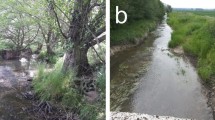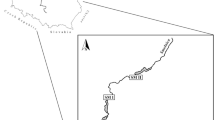Abstract
The Netherlands are a small, low-lying delta in W. Europe (42000 km2; 50°–54° N; 3°–8° E), mainly consisting of alluvial deposits from the North Sea and from the large rivers Rhine and Meuse. The country was `created by man'. The conversion of natural aquatic and terrestrial ecosystems into drained agricultural land was a major cultural operation over the past 1000 years. Roughly 55% of the country's surface area is still agricultural land. Some decades ago, The Netherlands' landscape was characterised by an armoured coastline and bridled estuaries, a drastically reduced area of saline and freshwater marshes, fully regulated rivers and streams, and numerous artificial lakes. The aquatic ecosystems beyond the influence of the large rivers, the Pleistocene raised bogs and moor lands, have almost been completely annihilated in the past. Acidification and eutrophication led to the deterioration of the remaining softwater lake vegetation. Last but not least, an artificial drainage system was constructed, leading to an unnatural water table all over the country, high in summer, low in winter. Only very recently, some 25 years ago, the tide has been turned and ecological rehabilitation and restoration of disturbed ecosystems are in full swing now, enhanced by the European Union policy to set aside agricultural land in the Netherlands in favour of the development of `nature'. The state of the art of aquatic and semi-aquatic ecological restoration projects in the Netherlands is given. Starting from the conceptual basis of restoration ecology, the successes and failures of hundreds of restoration projects are given. Numerous successful projects are mentioned. In general, ecological restoration endeavours are greatly benefiting from progressive experience in the course of the years. Failures mainly occur by insufficient application of physical, chemical or ecological principles. The spontaneous colonisation by plants and animals, following habitat reconstruction, is preferred. But sometimes the re-introduction of keystone species (e.g. eelgrass; salmon; beaver) is necessary in case the potential habitats are isolated or fragmented, or when a seed bank is lacking, thus not allowing viable populations to develop. Re-introduction of traditional management techniques (e.g. mowing without fertilisation; low intensity grazing) is important to rehabilitate the semi-natural and cultural landscapes, so characteristic for the Netherlands. For aquatic ecosystems proper (estuaries, rivers, streams, larger lakes) the rule of thumb is that re-establishment of the abiotic habitat conditions is a pre-requisite for the return of the target species. This implies rehabilitation of former hydrological end geomorphological conditions, and an increase in spatial heterogeneity. The `bottom-up' technique of lake restoration, viz. reduction in nutrient loadings, and removal of nutrient-rich organic sediment, is the preferred strategy. The `top-down' approach of curing eutrophicated ecosystems, that is drastic reduction of fish stock, mainly bream, and introduction of carnivorous fish, may be considered as complementary. For semi-aquatic ecosystems (river-fed and rain-fed peat moors, brook valleys, coastal dune slacks) it also counts that the abiotic constraints should be lifted, but here the species-oriented conservation strategy, the enhancement of the recovery of characteristic plant and animal species, is mainly followed. An important pre-requisite for the rehabilitation of the original natural or semi-natural
Similar content being viewed by others
References
Allen, E. B., W. W. Covington & D. A. Falk, 1997. Developing the conceptual basis for restoration ecology. Restorat. Ecol. 5: 275–276.
Bakker, J. P. & F. Berendse, 1999. Constraints in the restoration of ecological diversity in grassland and heathland communities. Trends Ecol. Evol. 14: 63–68.
Bakker, J. P., P. Esselink, K. S. Dijkema, W. E. van Duin & D. J. de Jong, 2002. Restoration of salt marshes in the Netherlands. Hydrobiologia 478/Dev. Hydrobiol. 166: 29–51.
Bakker, J. P. & G. Londo, 1998. Grazing for conservation management in historical perspective. In Wallis de Vries, F. M., J. P. Bakker & S. E. van Wieren (eds), Grazing and Conservation Management. Kluwer Academic Publishers, Dordrecht.: 23–54.
Bionieuws, 1998. Type I en II: over ecologische effectstudies, beslistheorie en een symmetrische bewijsvoering. Bionieuws 4,5,6 & 7 (in Dutch).
Blom, C. W. P. M., 1999. Adaptations to flooding stress: from plant community to molecule. Plant Biol. 1: 261–273.
Cals, M. J. R., R. Postma, A. D. Buijse & E. C. C. Marteijn, 1998. Habitat restoration along the river Rhine in the Netherlands: putting ideas into practice. Aquatic Conservation: Mar. Freshwat. Ecosystems 8: 61–70.
Carpenter, S. R., 1988. Transmission of variance through lake foodwebs. In Carpenter, S. R. (ed.), Complex Interactions in Lake Communities. Springer: 119–138.
De Groot, S. J., 2002. A review of the past and present status of anadromous fish species in the Netherlands: is restocking the Rhine feasible? Hydrobiologia 478/Dev. Hydrobiol. 166: 205–218.
De Jonge, V. N. & D. J. de Jong & M. M. van Katwijk, 2000. Policy plans and management measures to restore eelgrass (Zostera marina L.) in the Dutch Wadden Sea. Helgol. mar. Res. 54: 151–158.
De Jonge, V. N. & D. J. de Jong, 2002. Ecological restoration in coastal areas in the Netherlands: concepts, dilemmas and some examples. Hydrobiologia 478/Dev. Hydrobiol. 166: 7–28.
De Melo, R., R. France & D. J. McQueen, 1992. Biomanipulation: Hit or myth? Limnol. Oceanogr. 37: 192–207.
De Waal, L. C., A. R. G. Large & P. M. Wade (eds), 1998. Rehabilitation of Rivers. Principles and Implementation. Landscape Ecology Series, Wiley & Sons, Chichester.
Ehrenfeld, J. G., 2000. Defining the limits of restoration: the need for realistic goals. Restor. Ecol. 8: 2–9.
Grootjans, A. P. & R. van Diggelen, 1995. Assessing the restoration prospects of degraded fens. In Wheeler, B. C., S. C. Shaw, W. J. Fojt & R. A. Robertson (eds), Restoration of Temperate Wetlands. Wiley & Sons, Chichester: 73–90.
Grootjans, A. P., L. F. M. Fresco, C. C. de Leeuw & P. C. Schipper, 1996. Degeneration of species-rich Calthion palustris hay meadows; some considerations on the community concept. J. Veg. Sci. 7: 185–194.
Grootjans, A. P., J. P. Bakker, A. J. M. Jansen & R. H. Kemmers, 2002a. Restoration of brook valley meadows in the Netherlands. Hydrobiologia 478/Dev. Hydrobiol. 166: 149–170.
Grootjans, A. P., H.W. T. Geelen, A. J. M. Jansen & E. J. Lammerts, 2002b. Restoration of coastal dune slacks in the Netherlands. Hydrobiologia 478/Dev. Hydrobiol. 166: 181–203.
Gulati, R. D. & E. Van Donk, 1989. Biomanipulation in the Netherlands: applications in fresh-water ecosystems and estuarine waters-an introduction. Hydrobiol. Bull. 23: 1–42.
Gulati, A. D. & E. van Donk, 2002. Lakes in the Netherlands, their origin, eutrophication and restoration: state-of-the-art review. Hydrobiologia 148/Dev. Hydrobiol. 166: 73–106.
Hobbs, R. J. & D. A. Norton, 1996. Towards a conceptual framework for restoration ecology. Restorat. Ecol. 4: 93–110.
Hobbs, R. J. & J. A. Harris, 2001. Restoration Ecology: Repairing the Earth's Ecosystems in the New Millennium. Restorat. Ecol. 9: 239–246.
Hosper, S. H., 1997. Clearing lakes, an ecosystem approach to the restoration and management of shallow lakes in the Netherlands. Ph.D. Thesis, University of Wageningen.
Huisman, J., 2000A. Natuurontwikkeling is even onvoorspelbaar als het weer. Bionieuws 17 (in Dutch).
Huisman, J., 2000B. Ecologen moeten hun hand niet overspelen. Bionieuws 19 (in Dutch).
ICPR, 2000. Rhine 2020 Programme for Sustainable Development and Action Plan 2005. International Commission for the Protection of the Rhine, Koblenz.
Kuhn, T. S., 1962. The Structure of Scientific Revolutions. Univ. Chicago.
Lamers, L. P. M. & J. G. M. Roelofs, 2000. Natuurontwikkeling is wel goed te voorspellen. Bionieuws 18 (in Dutch).
Lamers, L. P. M., A. J. P. Smolders & J. G. M. Roelofs, 2002. The restoration of fens in the Netherlands. Hydrobiologia 478/Dev. Hydrobiol. 166: 107–130.
Londo, G., 1997. Natuurontwikkeling, Backhuys Publishers, Leiden (in Dutch).
Middleton, B., 1999. Wetland Restoration, Flood Pulsing, and Disturbance Dynamics. John Wiley & Sons.
Moss, B., 2000. Biodiversity in fresh waters-an issue of species preservation or species functioning. Envir. Cons. 27: 1–4.
Nienhuis, P. H., A. D. Buijse, R. S. E. W. Leuven, A. J. M. Smits, R. J. W. de Nooij & E. M. Samborska, 2002. Ecological rehabilitation of the lowland basin of the river Rhine (NW Europe). Hydrobiologia 478/Dev. Hydrobiol. 166: 53–72.
Palmer, M. A., R. F. Ambrose & N. L. Poff, 1997. Ecological theory and community restoration ecology. Restorat. Ecol. 5: 291–300.
Postma, R., M. J. J. Kerkhofs, G. B. M. Pedroli & J. G. M. Rademakers, 1996. Een stroom natuur. Natuurstreefbeelden voor Rijn en Maas. Watersysteemverkenningen 1996: 1-102, RIZA-nota 95.060 (in Dutch).
RIVM, 1999. Milieucompendium 1999. Het milieu in cijfers. Rijksinstituut voor Volksgezondheid en Milieu (RIVM) en Centraal Bureau voor de Statistiek, Bilthoven, Heerlen (in Dutch).
Roelofs, J. G. M., E. Brouwer & R. Bobbink, 2002. Restoration of aquatic macrophyte vegetation in acidified and eutrophicated soft water wetlands in the Netherlands. Hydrobiologia 478/Dev. Hydrobiol. 166: 171–180.
Scheffer, M., S. H. Hosper, M. L. Meijer, B. Moss & E. Jeppesen, 1993. Alternative equilibria in shallow lakes. Trends Ecol. Evol. 8: 275–279.
Schropp, M. H. I. & C. Bakker, 1998. Secondary channels as a basis for the ecological rehabilitation of Dutch rivers. Aquatic Conservation: Mar. Freshw. Ecosyst. 8: 53–59.
Shapiro, J. & D. I. Wright, 1984. Lake restoration by biomanipulations. Round Lake, Minesota-the first 2 years. Freshwat. Biol. 14: 371–373.
Southwood, T. R. E., 1977. Habitat, the templet for ecological strategies. J. anim. Ecol. 45: 337–365.
Townsend, C. R., 1996. Concepts in river ecology: pattern and process in the catchment hierarchy. Ergebn. Limnol. 113, Large Rivers 10: 3–21.
Thompson, K., J. P. Bakker & R. M. Bekker, 1997. Soil Seed Banks in North West Europe; Methodology, Density and Longevity. Cambridge Univ. Press, Cambridge.
Van Diggelen, R., A. P. Grootjans & J. A. Harris, 2001. Ecological restoration: State of the Art or State of the Science? Restorat. Ecol. 9: 115–118.
Van Duren, I. C., R. J. Strykstra, A. P. Grootjans, G. N. J. ter Heerdt & D. M. Pegtel, 1998. A multidisciplinary evaluation of restoration measures in degraded Cirsio-Molinietum fen meadows. Appl. Veg. Sci. 1: 115–130.
Van Katwijk, M. M., 2000. Possibilities for restoration of Zostera marina beds in the Dutch Wadden Sea. PhD Thesis University of Nijmegen.
Van Staalduinen, C. J., H. A. van Adrichem Boogaert, M. J. M. Bless, C. J. W. Doppert, H. M. Harsveldt, H. M. van Montfrans, E. Oele, R. E. Wermuth & W. H. Zagwijn, 1979. The Geology of the Netherlands, Meded. Rijks Geol. Dienst 31–32.
Verhagen, R., J. Klooker, J. P. Bakker & R. van Diggelen, 2001. Restoration success of low-production plant communities on former agricultural soils after top-soil removal. Appl. Vegetation Sci. 4: 75–82.
Verdonschot, P. F. M. & R. C. Nijboer, 2002. Towards a decision support system for stream restoration in the Netherlands. Hydrobiologia 478/Dev. Hydrobiol. 166: 131–148.
Westhoff, V., 1945. Biologische problemen der natuurbescherming. In Verslagen van de Natuurbeschermingsdag van de NJN te Drachten: 18–30 (in Dutch).
Whisenant, S. G., 1999. Repairing damaged wildlands: a processoriented, landscape-scale approach. Cambridge University Press, Cambridge.
Zedler, J. B., 2000. Progress in wetland restoration ecology. TREE 15: 402–407.
Zedler, J. B. (ed.), 2001. Handbook for Restoring Tidal Wetlands. Marine Science Series, CRC Press.
Author information
Authors and Affiliations
Rights and permissions
About this article
Cite this article
Nienhuis, P., Bakker, J., Grootjans, A. et al. The state of the art of aquatic and semi-aquatic ecological restoration projects in the Netherlands* . Hydrobiologia 478, 219–233 (2002). https://doi.org/10.1023/A:1021090900341
Issue Date:
DOI: https://doi.org/10.1023/A:1021090900341




